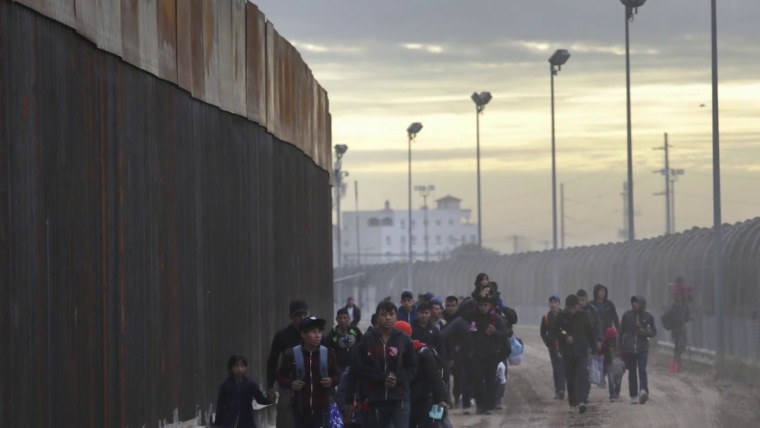WASHINGTON — A recent increase in the number of unaccompanied minors crossing the border means a new temporary shelter can only house 10 percent of the 7,070 unaccompanied minors held by the U.S., according to new data obtained by NBC News, which may force the Biden administration to build more such shelters.
In January 2021, 5,871 unaccompanied immigrants under the age of 18 crossed the border, up from 4,995 in December 2020, according to Customs and Border Protection data.
The number of migrants crossing the border often goes up during the transition between U.S. presidential administrations, but a Health and Human Services official who spoke on the condition of anonymity also attributed the uptick to the Biden administration allowing migrants to enter the U.S. who had otherwise been kept out by the Trump administration.
The number of unaccompanied asylum seekers who wind up in shelters run by HHS is expected to keep climbing. Advocates and some members of Congress say the administration should find alternatives to care for them instead of building more temporary facilities.
“This is not okay, never has been okay, never will be okay — no matter the administration or party,” Rep. Alexandria Ocasio-Cortez, D.-N.Y., said in a tweet reacting to the news of Monday’s opening of the Carrizo Springs facility for migrant children between ages 13 and 17. The Texas facility is the first of its kind to be opened under the Biden administration.
According to the data obtained by NBC News, as of Sunday, one day before the opening of Carrizo Springs, HHS’s child migrant shelters were at 93 percent of their operational capacity but only 53 percent of the capacity funded by Congress. They were receiving an average of 252 new children per day last week, while they were only able to discharge 97.
The HHS official who spoke to NBC News on the condition of anonymity attributed much of the current backlog to the winter weather emergency in Texas, which delayed flights for children to get to sponsors.
The official also said the agency’s capacity at permanent facilities has been reduced 40 percent due to Covid-19 measures and reopening some of those facilities could take more than a year. The official said HHS would like to reopen more of those permanent facilities, but has not ruled out opening other temporary influx shelters like Carrizo Springs.
“None of us want to open influx facilities, but even more so, none of us want kids in CBP custody for longer than they have to be,” the HHS official said. “So this is a short-term immediate stopgap until we can continue to build the licensed facility care provider network…and to release them to proper sponsors as well.”
The Miami Herald reported that the Biden administration already plans to reopen what was previously known as the Homestead Detention Center in Florida, now known as the Biscayne Influx Care Facility, as a temporary shelter to take in migrant children. The HHS official said nothing has been decided on whether to reopen this facility.
The data, however, suggests the Biden administration may need to expand beyond Homestead and Carrizo Springs, at least under existing rules governing the treatment of unaccompanied migrant children who arrive at the border.
While the number of children arriving at the border without parents or legal guardians is rising, so is the amount of time it takes HHS to find relatives or other sponsors to house the children in the U.S. while they wait for an asylum hearing.
According to the data obtained by NBC News, as of Sunday, one day before the opening of Carrizo Springs, HHS’s child migrant shelters were at 93 percent of their operational capacity but only 53 percent of the capacity funded by Congress. They were receiving an average of 252 new children per day last week, while they were only able to discharge 97.
The lag between children coming into the facilities and those able to be sent to live with sponsors is due to a rigorous vetting process by HHS. In 2014, during an influx in unaccompanied migrant children, HHS sent eight Guatemalan children to work in poor conditions on an Ohio egg farm, according to court documents. The incident triggered calls for sponsors to be more fully vetted before taking in migrant children.
Of particular concern is the amount of time children spend in CBP processing facilities. Under federal law, they should not be held more than 72 hours, but when HHS facilities became overcrowded during an immigration surge in mid-2019, more than 1,400 children were waiting longer than that as of May 31, causing some to go without baths or beds.
As of Sunday, according to the new data, only nine children had been waiting in CBP facilities over 72 hours, while a total of 709 were awaiting transfer to HHS.
Temporary government influx shelters on federal property are not governed by the same child welfare regulations that apply to permanent shelters.
These facilities were first used during the Obama administration, but at the height of the Trump administration’s family separation policy, after dozens of permanent facilities reached capacity, the administration relied on the Homestead, Florida facility and a second tent city in Tornillo, Texas.
Both facilities were criticized during the Trump administration for their treatment of migrant children during and after the family separation crisis in 2018.
The Carrizo Springs facility was opened in 2019 during the Trump administration to house minors but was closed after a month.
The migrant child advocacy group Kids in Need of Defense said in a statement that the temporary shelters should “only be used when truly necessary and unavoidable, and must be bound by minimum standards that provide for children’s safety and appropriate care, and that limit the use of such facilities to the briefest duration possible.”
Other groups, however, have called for the Biden administration to rush resources to the border so that they do not have to use the temporary facilities for children.
“It really should be an absolutely last resort,” said Lisa Koop, associate director of legal services at the National Immigrant Justice Center. “We’re probably pivoting to the influx facilities more quickly than we need to, and it comes at the expense of some of the alternatives,” including surging child welfare experts to border facilities to vet children and families soon after their arrival.
Source: | This article originally belongs to Nbcnews.com











